MBA HRM Assignment 2: TechnologyOne Business Expansion in China
VerifiedAdded on 2020/04/07
|22
|4369
|81
Project
AI Summary
This MBA HRM assignment analyzes TechnologyOne's potential business expansion into the IT sector in China. The report provides an executive summary and covers various aspects of the IT industry in China, including market growth, political and legal factors, and cultural considerations. It examines the differences between Australian and Chinese cultures, their impact on business practices, and negotiation strategies. The assignment also discusses HRM practices, challenges faced by TechnologyOne, and recommendations for successful business ventures. The report also provides a table of contents, figures and references to support the analysis. The analysis is aimed at providing insights into the Chinese market and helping TechnologyOne navigate the challenges and opportunities of doing business in China.
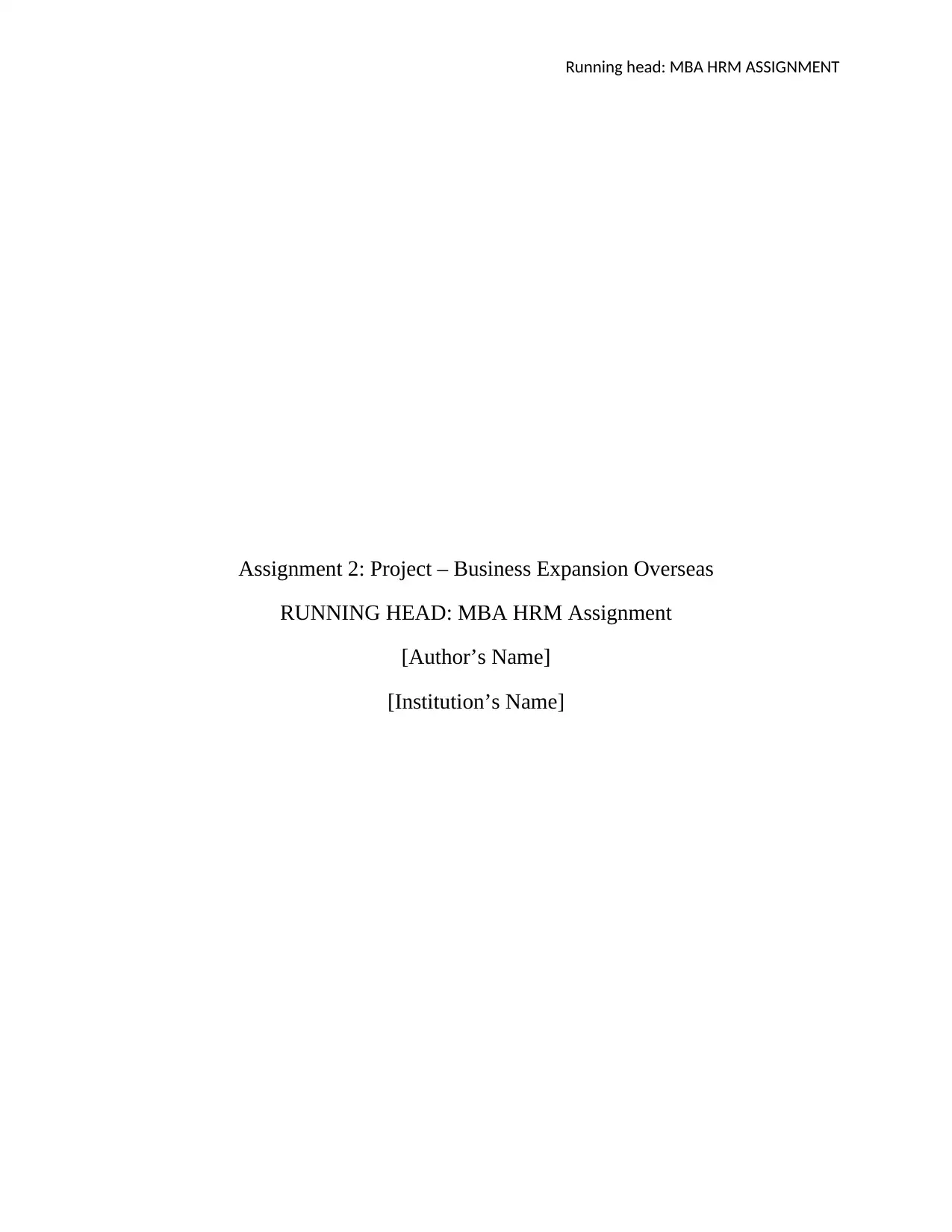
Running head: MBA HRM ASSIGNMENT
Assignment 2: Project – Business Expansion Overseas
RUNNING HEAD: MBA HRM Assignment
[Author’s Name]
[Institution’s Name]
Assignment 2: Project – Business Expansion Overseas
RUNNING HEAD: MBA HRM Assignment
[Author’s Name]
[Institution’s Name]
Paraphrase This Document
Need a fresh take? Get an instant paraphrase of this document with our AI Paraphraser
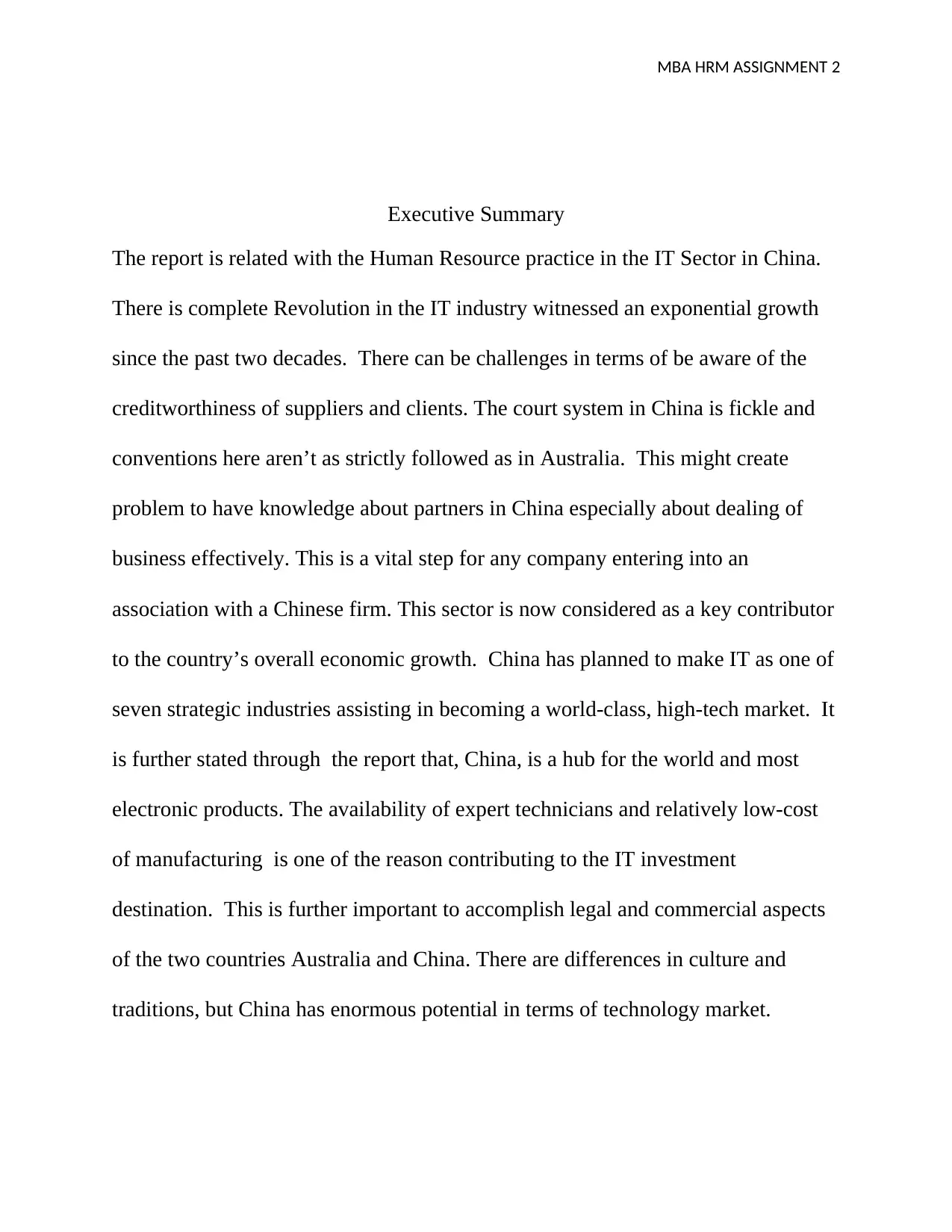
MBA HRM ASSIGNMENT 2
Executive Summary
The report is related with the Human Resource practice in the IT Sector in China.
There is complete Revolution in the IT industry witnessed an exponential growth
since the past two decades. There can be challenges in terms of be aware of the
creditworthiness of suppliers and clients. The court system in China is fickle and
conventions here aren’t as strictly followed as in Australia. This might create
problem to have knowledge about partners in China especially about dealing of
business effectively. This is a vital step for any company entering into an
association with a Chinese firm. This sector is now considered as a key contributor
to the country’s overall economic growth. China has planned to make IT as one of
seven strategic industries assisting in becoming a world-class, high-tech market. It
is further stated through the report that, China, is a hub for the world and most
electronic products. The availability of expert technicians and relatively low-cost
of manufacturing is one of the reason contributing to the IT investment
destination. This is further important to accomplish legal and commercial aspects
of the two countries Australia and China. There are differences in culture and
traditions, but China has enormous potential in terms of technology market.
Executive Summary
The report is related with the Human Resource practice in the IT Sector in China.
There is complete Revolution in the IT industry witnessed an exponential growth
since the past two decades. There can be challenges in terms of be aware of the
creditworthiness of suppliers and clients. The court system in China is fickle and
conventions here aren’t as strictly followed as in Australia. This might create
problem to have knowledge about partners in China especially about dealing of
business effectively. This is a vital step for any company entering into an
association with a Chinese firm. This sector is now considered as a key contributor
to the country’s overall economic growth. China has planned to make IT as one of
seven strategic industries assisting in becoming a world-class, high-tech market. It
is further stated through the report that, China, is a hub for the world and most
electronic products. The availability of expert technicians and relatively low-cost
of manufacturing is one of the reason contributing to the IT investment
destination. This is further important to accomplish legal and commercial aspects
of the two countries Australia and China. There are differences in culture and
traditions, but China has enormous potential in terms of technology market.
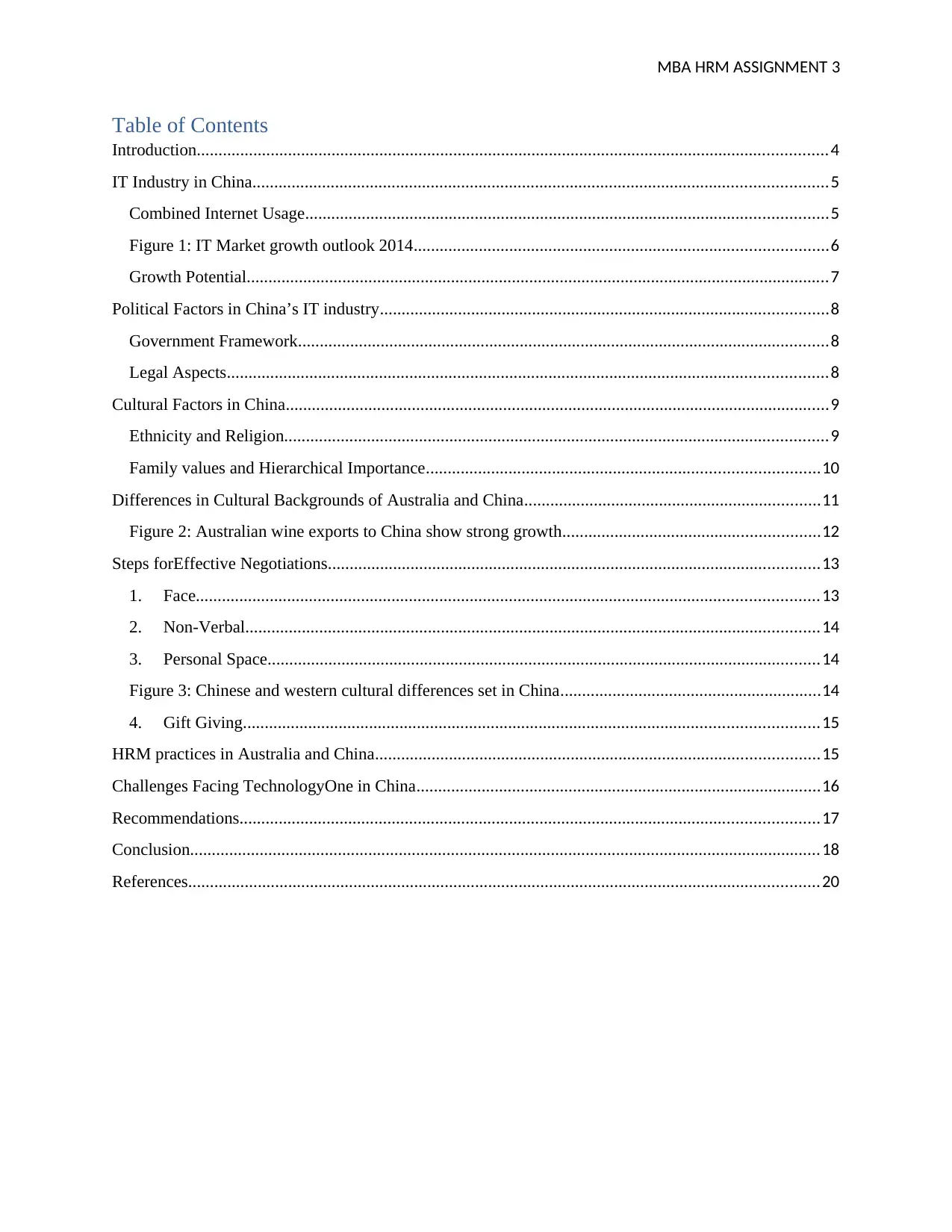
MBA HRM ASSIGNMENT 3
Table of Contents
Introduction.................................................................................................................................................4
IT Industry in China....................................................................................................................................5
Combined Internet Usage........................................................................................................................5
Figure 1: IT Market growth outlook 2014...............................................................................................6
Growth Potential......................................................................................................................................7
Political Factors in China’s IT industry.......................................................................................................8
Government Framework..........................................................................................................................8
Legal Aspects..........................................................................................................................................8
Cultural Factors in China.............................................................................................................................9
Ethnicity and Religion.............................................................................................................................9
Family values and Hierarchical Importance..........................................................................................10
Differences in Cultural Backgrounds of Australia and China....................................................................11
Figure 2: Australian wine exports to China show strong growth...........................................................12
Steps forEffective Negotiations.................................................................................................................13
1. Face...............................................................................................................................................13
2. Non-Verbal....................................................................................................................................14
3. Personal Space...............................................................................................................................14
Figure 3: Chinese and western cultural differences set in China............................................................14
4. Gift Giving....................................................................................................................................15
HRM practices in Australia and China......................................................................................................15
Challenges Facing TechnologyOne in China.............................................................................................16
Recommendations.....................................................................................................................................17
Conclusion.................................................................................................................................................18
References.................................................................................................................................................20
Table of Contents
Introduction.................................................................................................................................................4
IT Industry in China....................................................................................................................................5
Combined Internet Usage........................................................................................................................5
Figure 1: IT Market growth outlook 2014...............................................................................................6
Growth Potential......................................................................................................................................7
Political Factors in China’s IT industry.......................................................................................................8
Government Framework..........................................................................................................................8
Legal Aspects..........................................................................................................................................8
Cultural Factors in China.............................................................................................................................9
Ethnicity and Religion.............................................................................................................................9
Family values and Hierarchical Importance..........................................................................................10
Differences in Cultural Backgrounds of Australia and China....................................................................11
Figure 2: Australian wine exports to China show strong growth...........................................................12
Steps forEffective Negotiations.................................................................................................................13
1. Face...............................................................................................................................................13
2. Non-Verbal....................................................................................................................................14
3. Personal Space...............................................................................................................................14
Figure 3: Chinese and western cultural differences set in China............................................................14
4. Gift Giving....................................................................................................................................15
HRM practices in Australia and China......................................................................................................15
Challenges Facing TechnologyOne in China.............................................................................................16
Recommendations.....................................................................................................................................17
Conclusion.................................................................................................................................................18
References.................................................................................................................................................20
⊘ This is a preview!⊘
Do you want full access?
Subscribe today to unlock all pages.

Trusted by 1+ million students worldwide
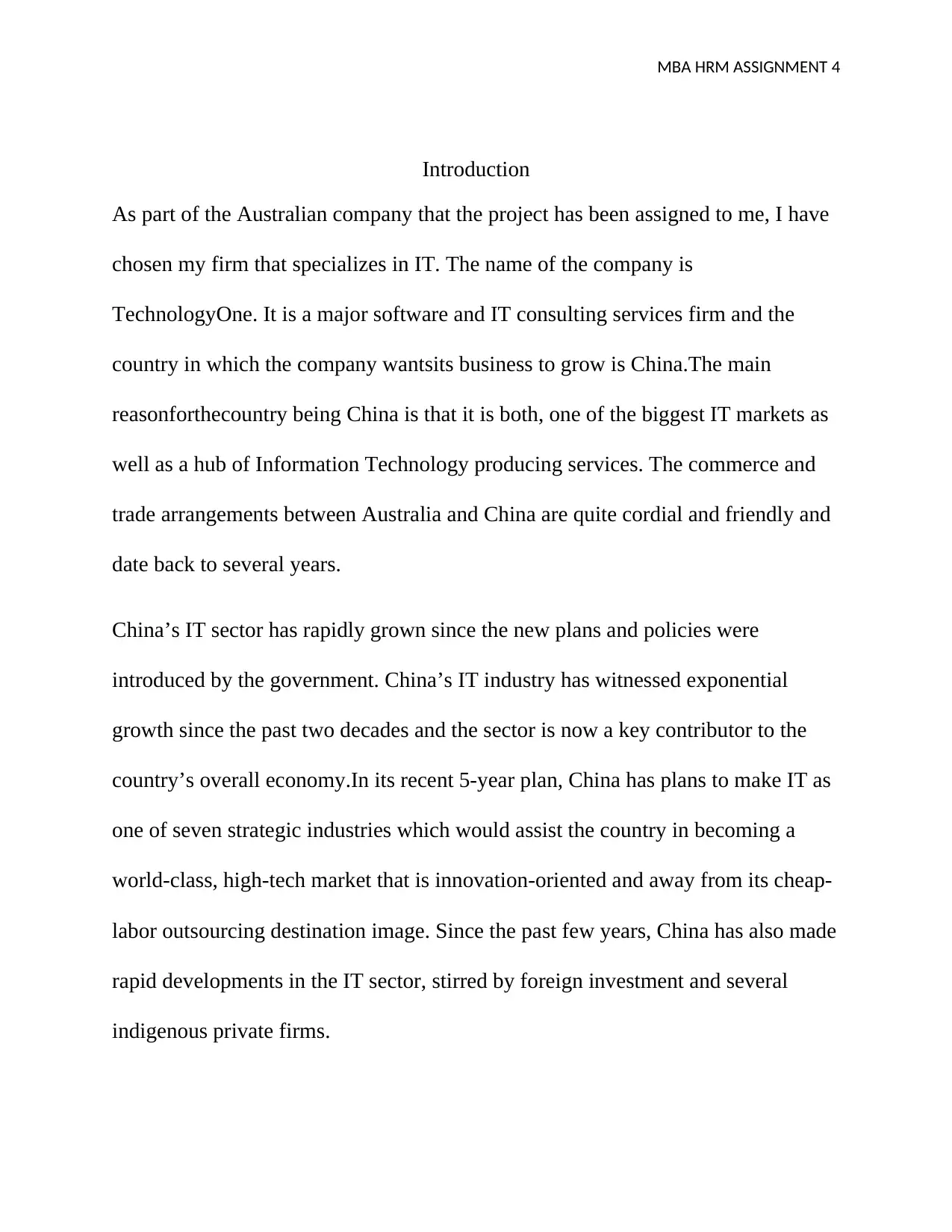
MBA HRM ASSIGNMENT 4
Introduction
As part of the Australian company that the project has been assigned to me, I have
chosen my firm that specializes in IT. The name of the company is
TechnologyOne. It is a major software and IT consulting services firm and the
country in which the company wantsits business to grow is China.The main
reasonforthecountry being China is that it is both, one of the biggest IT markets as
well as a hub of Information Technology producing services. The commerce and
trade arrangements between Australia and China are quite cordial and friendly and
date back to several years.
China’s IT sector has rapidly grown since the new plans and policies were
introduced by the government. China’s IT industry has witnessed exponential
growth since the past two decades and the sector is now a key contributor to the
country’s overall economy.In its recent 5-year plan, China has plans to make IT as
one of seven strategic industries which would assist the country in becoming a
world-class, high-tech market that is innovation-oriented and away from its cheap-
labor outsourcing destination image. Since the past few years, China has also made
rapid developments in the IT sector, stirred by foreign investment and several
indigenous private firms.
Introduction
As part of the Australian company that the project has been assigned to me, I have
chosen my firm that specializes in IT. The name of the company is
TechnologyOne. It is a major software and IT consulting services firm and the
country in which the company wantsits business to grow is China.The main
reasonforthecountry being China is that it is both, one of the biggest IT markets as
well as a hub of Information Technology producing services. The commerce and
trade arrangements between Australia and China are quite cordial and friendly and
date back to several years.
China’s IT sector has rapidly grown since the new plans and policies were
introduced by the government. China’s IT industry has witnessed exponential
growth since the past two decades and the sector is now a key contributor to the
country’s overall economy.In its recent 5-year plan, China has plans to make IT as
one of seven strategic industries which would assist the country in becoming a
world-class, high-tech market that is innovation-oriented and away from its cheap-
labor outsourcing destination image. Since the past few years, China has also made
rapid developments in the IT sector, stirred by foreign investment and several
indigenous private firms.
Paraphrase This Document
Need a fresh take? Get an instant paraphrase of this document with our AI Paraphraser
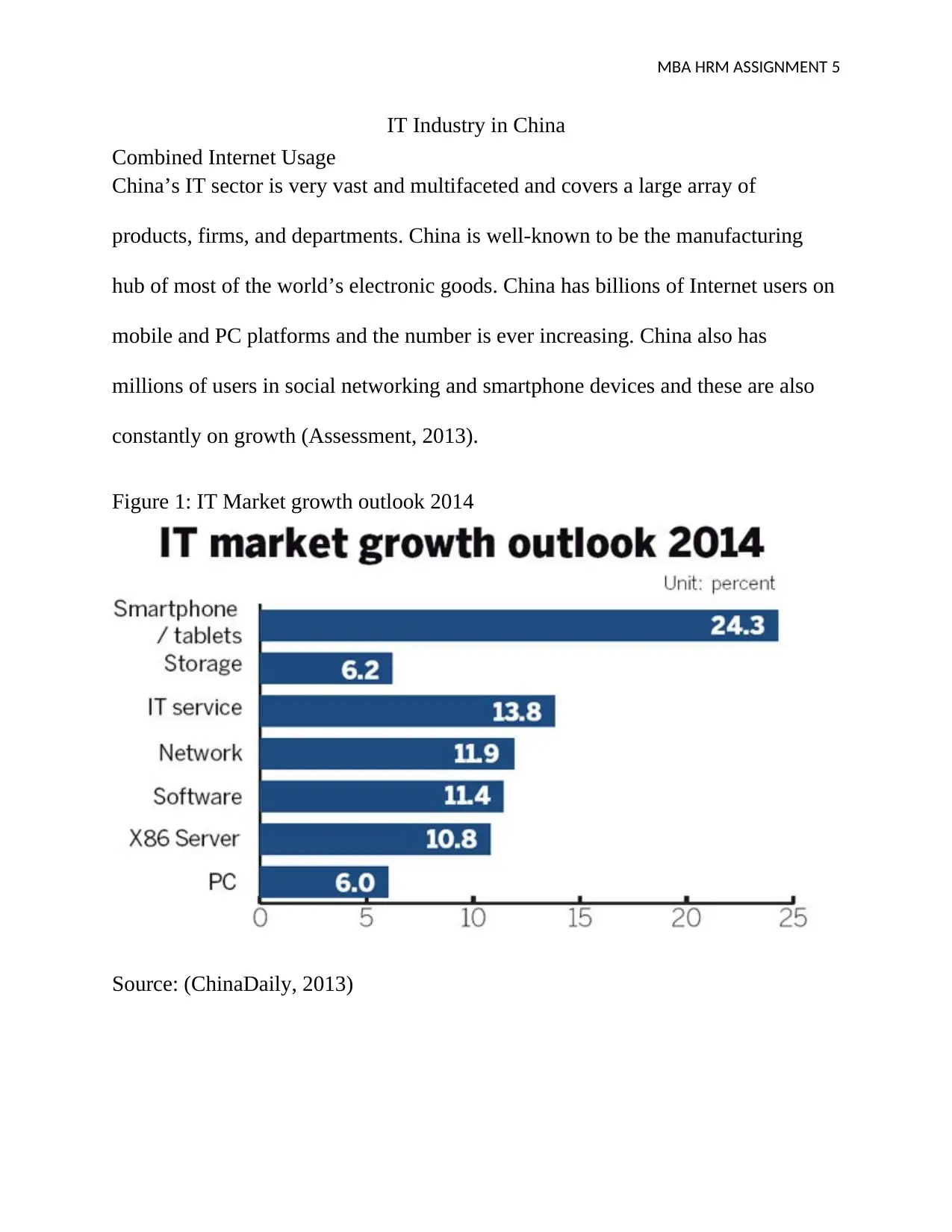
MBA HRM ASSIGNMENT 5
IT Industry in China
Combined Internet Usage
China’s IT sector is very vast and multifaceted and covers a large array of
products, firms, and departments. China is well-known to be the manufacturing
hub of most of the world’s electronic goods. China has billions of Internet users on
mobile and PC platforms and the number is ever increasing. China also has
millions of users in social networking and smartphone devices and these are also
constantly on growth (Assessment, 2013).
Figure 1: IT Market growth outlook 2014
Source: (ChinaDaily, 2013)
IT Industry in China
Combined Internet Usage
China’s IT sector is very vast and multifaceted and covers a large array of
products, firms, and departments. China is well-known to be the manufacturing
hub of most of the world’s electronic goods. China has billions of Internet users on
mobile and PC platforms and the number is ever increasing. China also has
millions of users in social networking and smartphone devices and these are also
constantly on growth (Assessment, 2013).
Figure 1: IT Market growth outlook 2014
Source: (ChinaDaily, 2013)
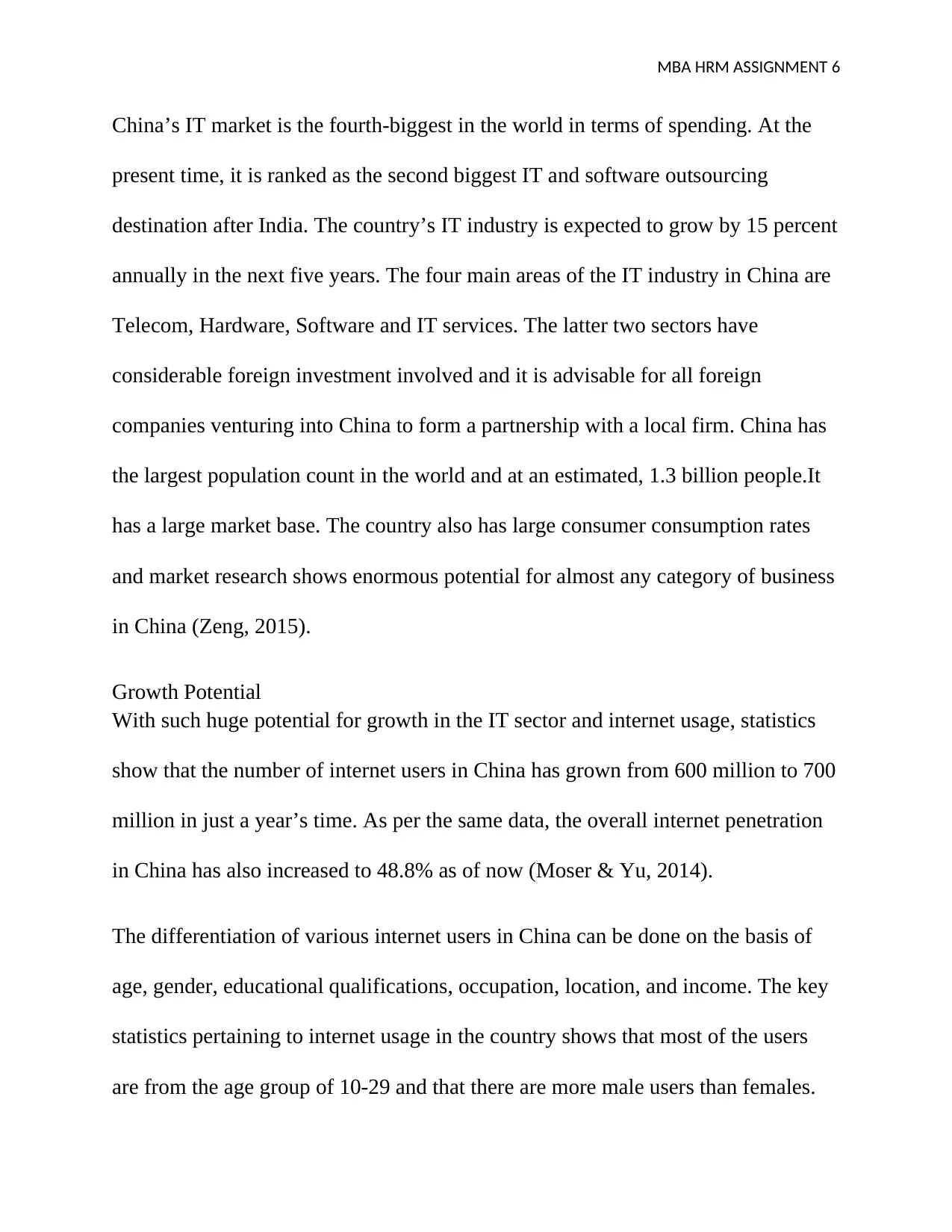
MBA HRM ASSIGNMENT 6
China’s IT market is the fourth-biggest in the world in terms of spending. At the
present time, it is ranked as the second biggest IT and software outsourcing
destination after India. The country’s IT industry is expected to grow by 15 percent
annually in the next five years. The four main areas of the IT industry in China are
Telecom, Hardware, Software and IT services. The latter two sectors have
considerable foreign investment involved and it is advisable for all foreign
companies venturing into China to form a partnership with a local firm. China has
the largest population count in the world and at an estimated, 1.3 billion people.It
has a large market base. The country also has large consumer consumption rates
and market research shows enormous potential for almost any category of business
in China (Zeng, 2015).
Growth Potential
With such huge potential for growth in the IT sector and internet usage, statistics
show that the number of internet users in China has grown from 600 million to 700
million in just a year’s time. As per the same data, the overall internet penetration
in China has also increased to 48.8% as of now (Moser & Yu, 2014).
The differentiation of various internet users in China can be done on the basis of
age, gender, educational qualifications, occupation, location, and income. The key
statistics pertaining to internet usage in the country shows that most of the users
are from the age group of 10-29 and that there are more male users than females.
China’s IT market is the fourth-biggest in the world in terms of spending. At the
present time, it is ranked as the second biggest IT and software outsourcing
destination after India. The country’s IT industry is expected to grow by 15 percent
annually in the next five years. The four main areas of the IT industry in China are
Telecom, Hardware, Software and IT services. The latter two sectors have
considerable foreign investment involved and it is advisable for all foreign
companies venturing into China to form a partnership with a local firm. China has
the largest population count in the world and at an estimated, 1.3 billion people.It
has a large market base. The country also has large consumer consumption rates
and market research shows enormous potential for almost any category of business
in China (Zeng, 2015).
Growth Potential
With such huge potential for growth in the IT sector and internet usage, statistics
show that the number of internet users in China has grown from 600 million to 700
million in just a year’s time. As per the same data, the overall internet penetration
in China has also increased to 48.8% as of now (Moser & Yu, 2014).
The differentiation of various internet users in China can be done on the basis of
age, gender, educational qualifications, occupation, location, and income. The key
statistics pertaining to internet usage in the country shows that most of the users
are from the age group of 10-29 and that there are more male users than females.
⊘ This is a preview!⊘
Do you want full access?
Subscribe today to unlock all pages.

Trusted by 1+ million students worldwide
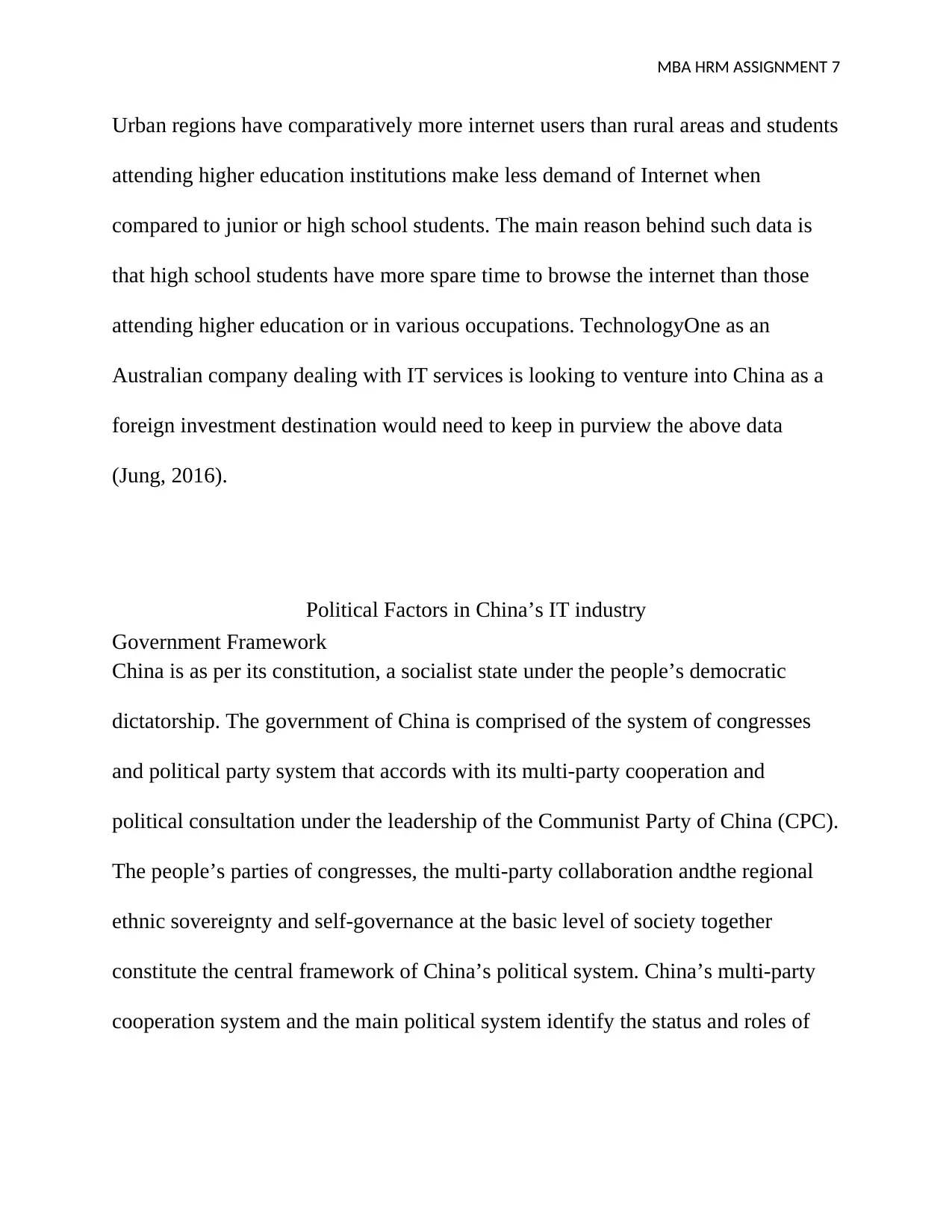
MBA HRM ASSIGNMENT 7
Urban regions have comparatively more internet users than rural areas and students
attending higher education institutions make less demand of Internet when
compared to junior or high school students. The main reason behind such data is
that high school students have more spare time to browse the internet than those
attending higher education or in various occupations. TechnologyOne as an
Australian company dealing with IT services is looking to venture into China as a
foreign investment destination would need to keep in purview the above data
(Jung, 2016).
Political Factors in China’s IT industry
Government Framework
China is as per its constitution, a socialist state under the people’s democratic
dictatorship. The government of China is comprised of the system of congresses
and political party system that accords with its multi-party cooperation and
political consultation under the leadership of the Communist Party of China (CPC).
The people’s parties of congresses, the multi-party collaboration andthe regional
ethnic sovereignty and self-governance at the basic level of society together
constitute the central framework of China’s political system. China’s multi-party
cooperation system and the main political system identify the status and roles of
Urban regions have comparatively more internet users than rural areas and students
attending higher education institutions make less demand of Internet when
compared to junior or high school students. The main reason behind such data is
that high school students have more spare time to browse the internet than those
attending higher education or in various occupations. TechnologyOne as an
Australian company dealing with IT services is looking to venture into China as a
foreign investment destination would need to keep in purview the above data
(Jung, 2016).
Political Factors in China’s IT industry
Government Framework
China is as per its constitution, a socialist state under the people’s democratic
dictatorship. The government of China is comprised of the system of congresses
and political party system that accords with its multi-party cooperation and
political consultation under the leadership of the Communist Party of China (CPC).
The people’s parties of congresses, the multi-party collaboration andthe regional
ethnic sovereignty and self-governance at the basic level of society together
constitute the central framework of China’s political system. China’s multi-party
cooperation system and the main political system identify the status and roles of
Paraphrase This Document
Need a fresh take? Get an instant paraphrase of this document with our AI Paraphraser
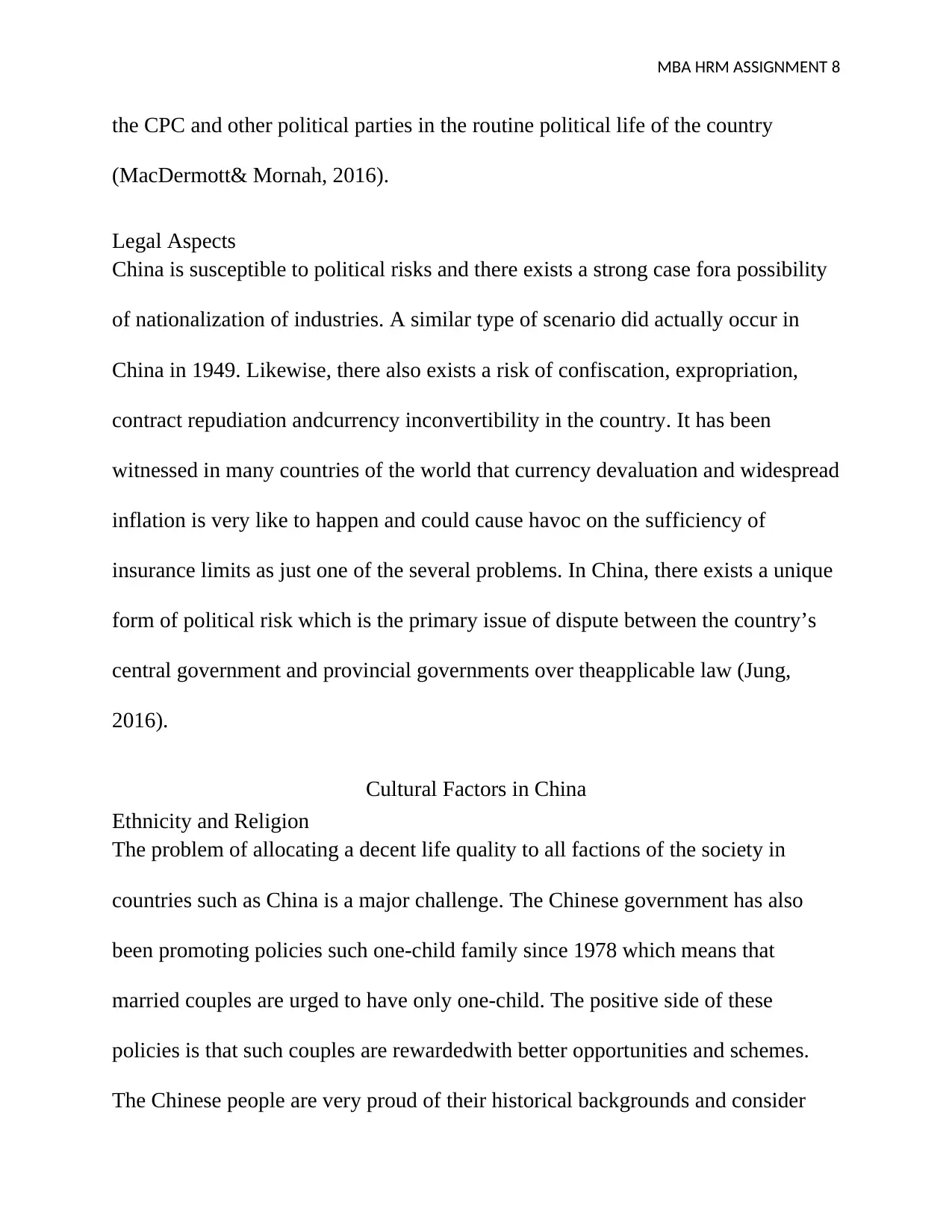
MBA HRM ASSIGNMENT 8
the CPC and other political parties in the routine political life of the country
(MacDermott& Mornah, 2016).
Legal Aspects
China is susceptible to political risks and there exists a strong case fora possibility
of nationalization of industries. A similar type of scenario did actually occur in
China in 1949. Likewise, there also exists a risk of confiscation, expropriation,
contract repudiation andcurrency inconvertibility in the country. It has been
witnessed in many countries of the world that currency devaluation and widespread
inflation is very like to happen and could cause havoc on the sufficiency of
insurance limits as just one of the several problems. In China, there exists a unique
form of political risk which is the primary issue of dispute between the country’s
central government and provincial governments over theapplicable law (Jung,
2016).
Cultural Factors in China
Ethnicity and Religion
The problem of allocating a decent life quality to all factions of the society in
countries such as China is a major challenge. The Chinese government has also
been promoting policies such one-child family since 1978 which means that
married couples are urged to have only one-child. The positive side of these
policies is that such couples are rewardedwith better opportunities and schemes.
The Chinese people are very proud of their historical backgrounds and consider
the CPC and other political parties in the routine political life of the country
(MacDermott& Mornah, 2016).
Legal Aspects
China is susceptible to political risks and there exists a strong case fora possibility
of nationalization of industries. A similar type of scenario did actually occur in
China in 1949. Likewise, there also exists a risk of confiscation, expropriation,
contract repudiation andcurrency inconvertibility in the country. It has been
witnessed in many countries of the world that currency devaluation and widespread
inflation is very like to happen and could cause havoc on the sufficiency of
insurance limits as just one of the several problems. In China, there exists a unique
form of political risk which is the primary issue of dispute between the country’s
central government and provincial governments over theapplicable law (Jung,
2016).
Cultural Factors in China
Ethnicity and Religion
The problem of allocating a decent life quality to all factions of the society in
countries such as China is a major challenge. The Chinese government has also
been promoting policies such one-child family since 1978 which means that
married couples are urged to have only one-child. The positive side of these
policies is that such couples are rewardedwith better opportunities and schemes.
The Chinese people are very proud of their historical backgrounds and consider
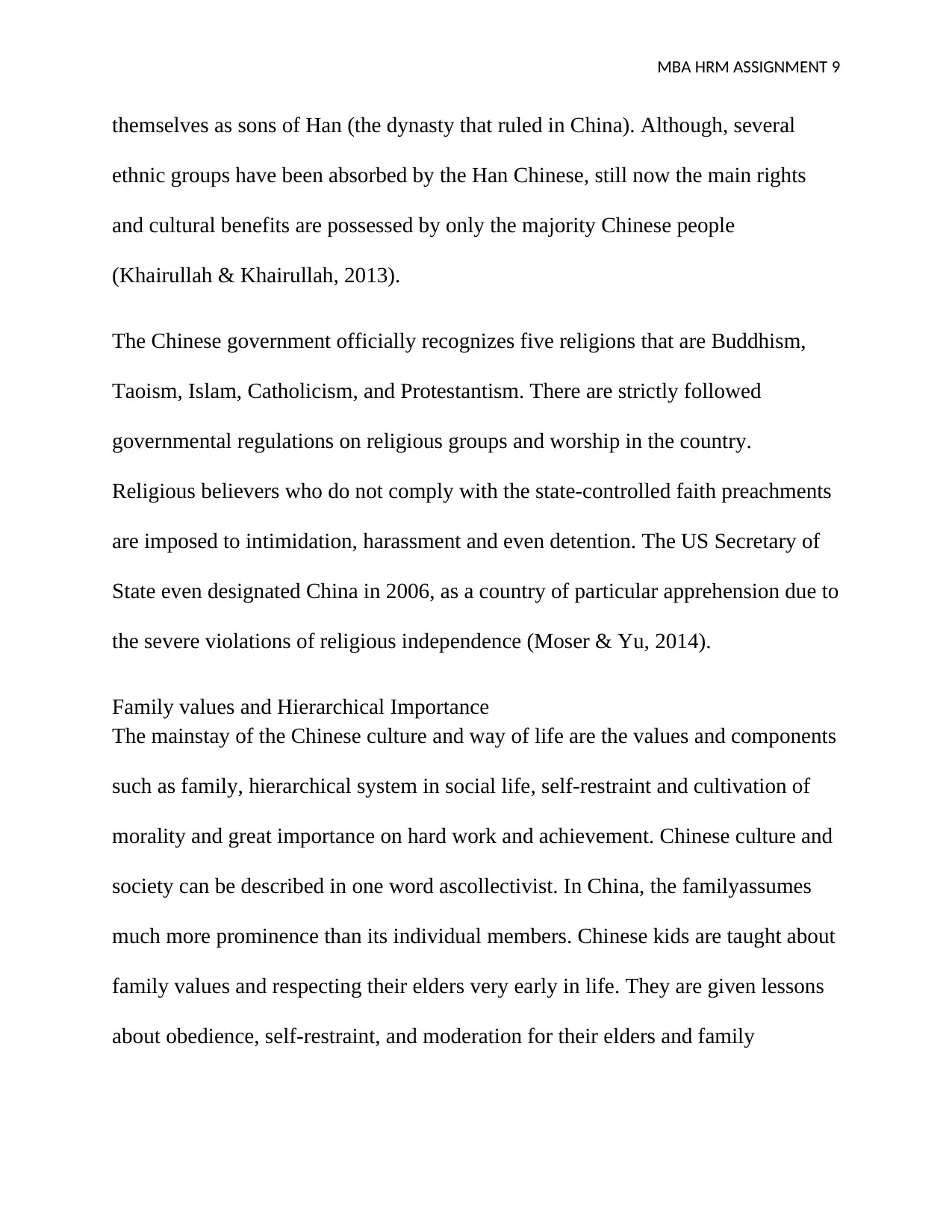
MBA HRM ASSIGNMENT 9
themselves as sons of Han (the dynasty that ruled in China). Although, several
ethnic groups have been absorbed by the Han Chinese, still now the main rights
and cultural benefits are possessed by only the majority Chinese people
(Khairullah & Khairullah, 2013).
The Chinese government officially recognizes five religions that are Buddhism,
Taoism, Islam, Catholicism, and Protestantism. There are strictly followed
governmental regulations on religious groups and worship in the country.
Religious believers who do not comply with the state-controlled faith preachments
are imposed to intimidation, harassment and even detention. The US Secretary of
State even designated China in 2006, as a country of particular apprehension due to
the severe violations of religious independence (Moser & Yu, 2014).
Family values and Hierarchical Importance
The mainstay of the Chinese culture and way of life are the values and components
such as family, hierarchical system in social life, self-restraint and cultivation of
morality and great importance on hard work and achievement. Chinese culture and
society can be described in one word ascollectivist. In China, the familyassumes
much more prominence than its individual members. Chinese kids are taught about
family values and respecting their elders very early in life. They are given lessons
about obedience, self-restraint, and moderation for their elders and family
themselves as sons of Han (the dynasty that ruled in China). Although, several
ethnic groups have been absorbed by the Han Chinese, still now the main rights
and cultural benefits are possessed by only the majority Chinese people
(Khairullah & Khairullah, 2013).
The Chinese government officially recognizes five religions that are Buddhism,
Taoism, Islam, Catholicism, and Protestantism. There are strictly followed
governmental regulations on religious groups and worship in the country.
Religious believers who do not comply with the state-controlled faith preachments
are imposed to intimidation, harassment and even detention. The US Secretary of
State even designated China in 2006, as a country of particular apprehension due to
the severe violations of religious independence (Moser & Yu, 2014).
Family values and Hierarchical Importance
The mainstay of the Chinese culture and way of life are the values and components
such as family, hierarchical system in social life, self-restraint and cultivation of
morality and great importance on hard work and achievement. Chinese culture and
society can be described in one word ascollectivist. In China, the familyassumes
much more prominence than its individual members. Chinese kids are taught about
family values and respecting their elders very early in life. They are given lessons
about obedience, self-restraint, and moderation for their elders and family
⊘ This is a preview!⊘
Do you want full access?
Subscribe today to unlock all pages.

Trusted by 1+ million students worldwide
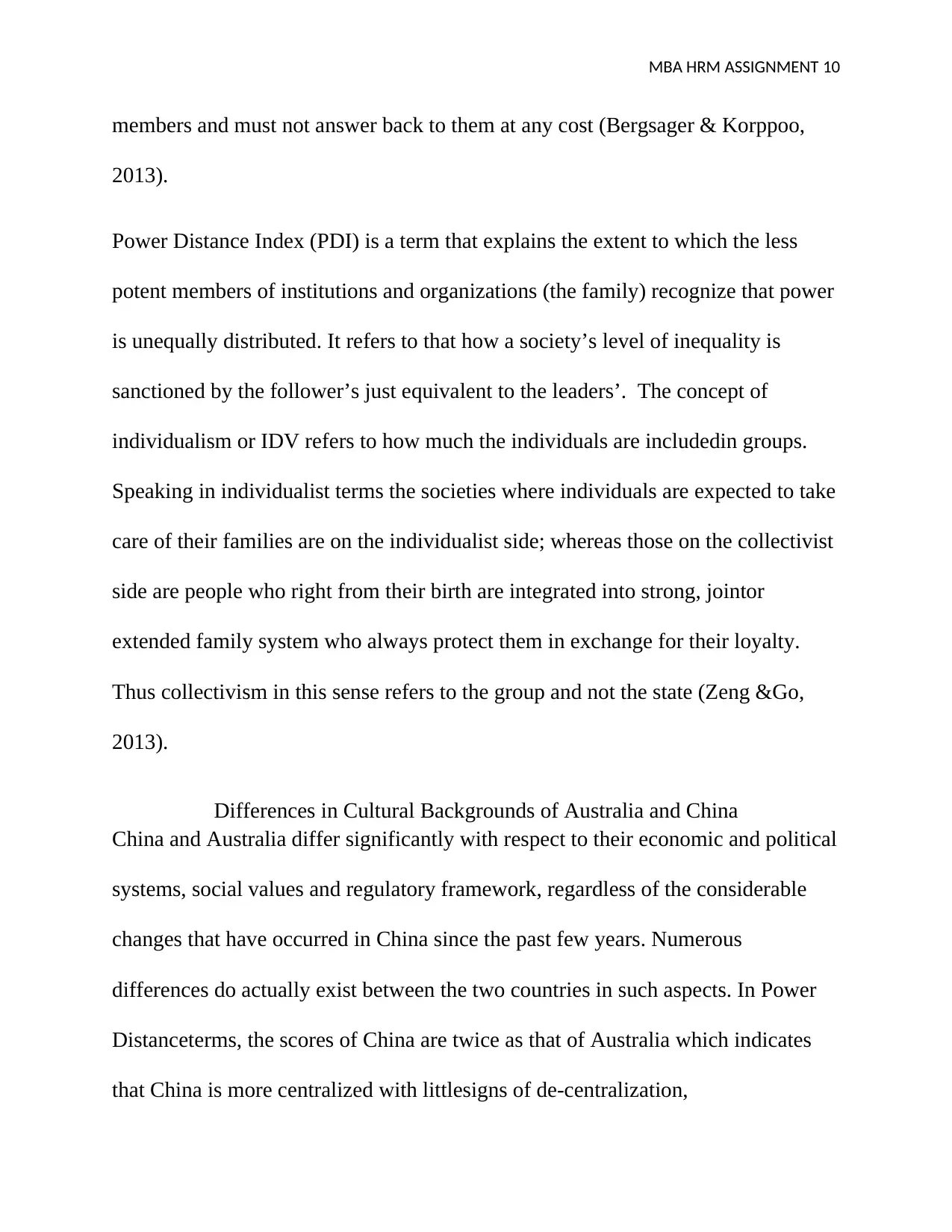
MBA HRM ASSIGNMENT 10
members and must not answer back to them at any cost (Bergsager & Korppoo,
2013).
Power Distance Index (PDI) is a term that explains the extent to which the less
potent members of institutions and organizations (the family) recognize that power
is unequally distributed. It refers to that how a society’s level of inequality is
sanctioned by the follower’s just equivalent to the leaders’. The concept of
individualism or IDV refers to how much the individuals are includedin groups.
Speaking in individualist terms the societies where individuals are expected to take
care of their families are on the individualist side; whereas those on the collectivist
side are people who right from their birth are integrated into strong, jointor
extended family system who always protect them in exchange for their loyalty.
Thus collectivism in this sense refers to the group and not the state (Zeng &Go,
2013).
Differences in Cultural Backgrounds of Australia and China
China and Australia differ significantly with respect to their economic and political
systems, social values and regulatory framework, regardless of the considerable
changes that have occurred in China since the past few years. Numerous
differences do actually exist between the two countries in such aspects. In Power
Distanceterms, the scores of China are twice as that of Australia which indicates
that China is more centralized with littlesigns of de-centralization,
members and must not answer back to them at any cost (Bergsager & Korppoo,
2013).
Power Distance Index (PDI) is a term that explains the extent to which the less
potent members of institutions and organizations (the family) recognize that power
is unequally distributed. It refers to that how a society’s level of inequality is
sanctioned by the follower’s just equivalent to the leaders’. The concept of
individualism or IDV refers to how much the individuals are includedin groups.
Speaking in individualist terms the societies where individuals are expected to take
care of their families are on the individualist side; whereas those on the collectivist
side are people who right from their birth are integrated into strong, jointor
extended family system who always protect them in exchange for their loyalty.
Thus collectivism in this sense refers to the group and not the state (Zeng &Go,
2013).
Differences in Cultural Backgrounds of Australia and China
China and Australia differ significantly with respect to their economic and political
systems, social values and regulatory framework, regardless of the considerable
changes that have occurred in China since the past few years. Numerous
differences do actually exist between the two countries in such aspects. In Power
Distanceterms, the scores of China are twice as that of Australia which indicates
that China is more centralized with littlesigns of de-centralization,
Paraphrase This Document
Need a fresh take? Get an instant paraphrase of this document with our AI Paraphraser
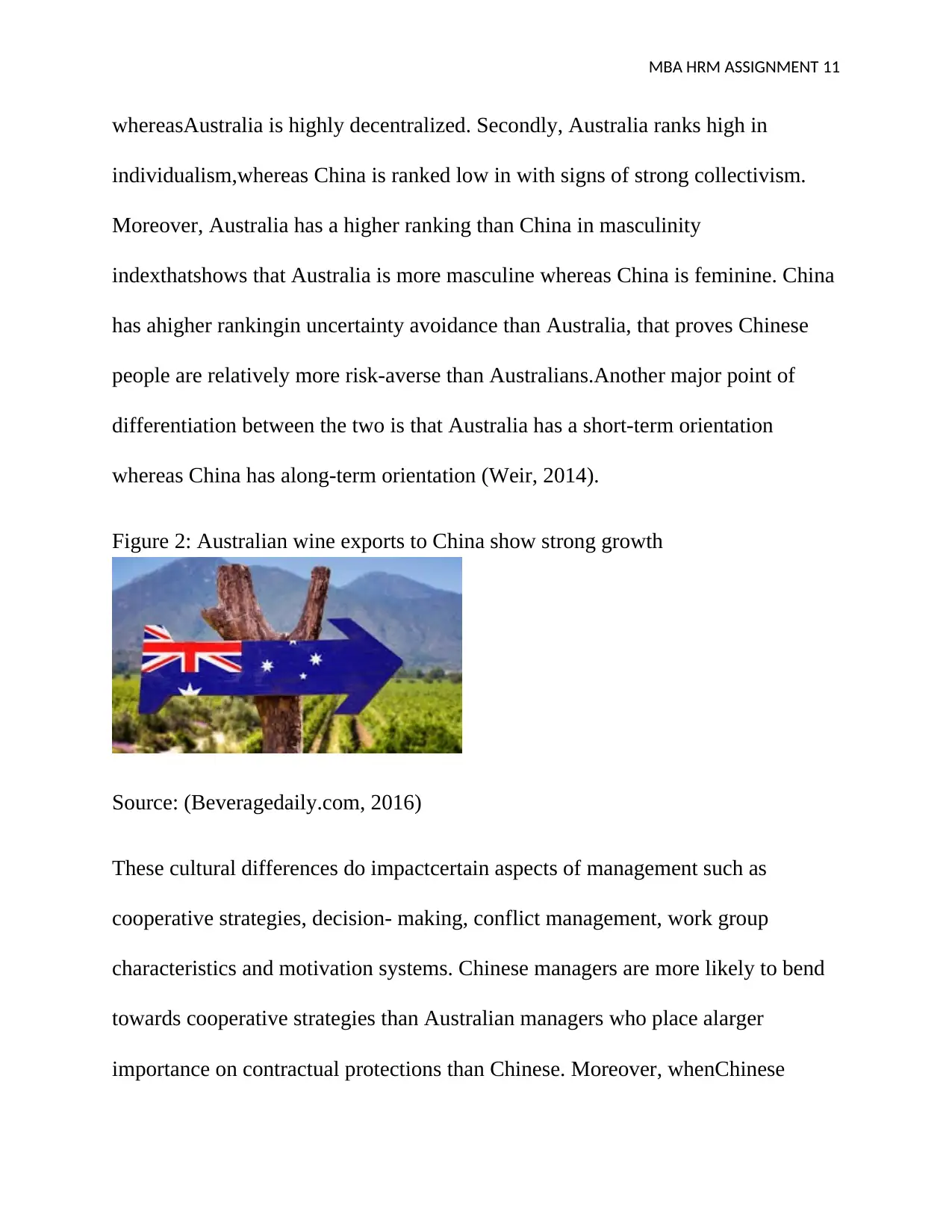
MBA HRM ASSIGNMENT 11
whereasAustralia is highly decentralized. Secondly, Australia ranks high in
individualism,whereas China is ranked low in with signs of strong collectivism.
Moreover, Australia has a higher ranking than China in masculinity
indexthatshows that Australia is more masculine whereas China is feminine. China
has ahigher rankingin uncertainty avoidance than Australia, that proves Chinese
people are relatively more risk-averse than Australians.Another major point of
differentiation between the two is that Australia has a short-term orientation
whereas China has along-term orientation (Weir, 2014).
Figure 2: Australian wine exports to China show strong growth
Source: (Beveragedaily.com, 2016)
These cultural differences do impactcertain aspects of management such as
cooperative strategies, decision- making, conflict management, work group
characteristics and motivation systems. Chinese managers are more likely to bend
towards cooperative strategies than Australian managers who place alarger
importance on contractual protections than Chinese. Moreover, whenChinese
whereasAustralia is highly decentralized. Secondly, Australia ranks high in
individualism,whereas China is ranked low in with signs of strong collectivism.
Moreover, Australia has a higher ranking than China in masculinity
indexthatshows that Australia is more masculine whereas China is feminine. China
has ahigher rankingin uncertainty avoidance than Australia, that proves Chinese
people are relatively more risk-averse than Australians.Another major point of
differentiation between the two is that Australia has a short-term orientation
whereas China has along-term orientation (Weir, 2014).
Figure 2: Australian wine exports to China show strong growth
Source: (Beveragedaily.com, 2016)
These cultural differences do impactcertain aspects of management such as
cooperative strategies, decision- making, conflict management, work group
characteristics and motivation systems. Chinese managers are more likely to bend
towards cooperative strategies than Australian managers who place alarger
importance on contractual protections than Chinese. Moreover, whenChinese
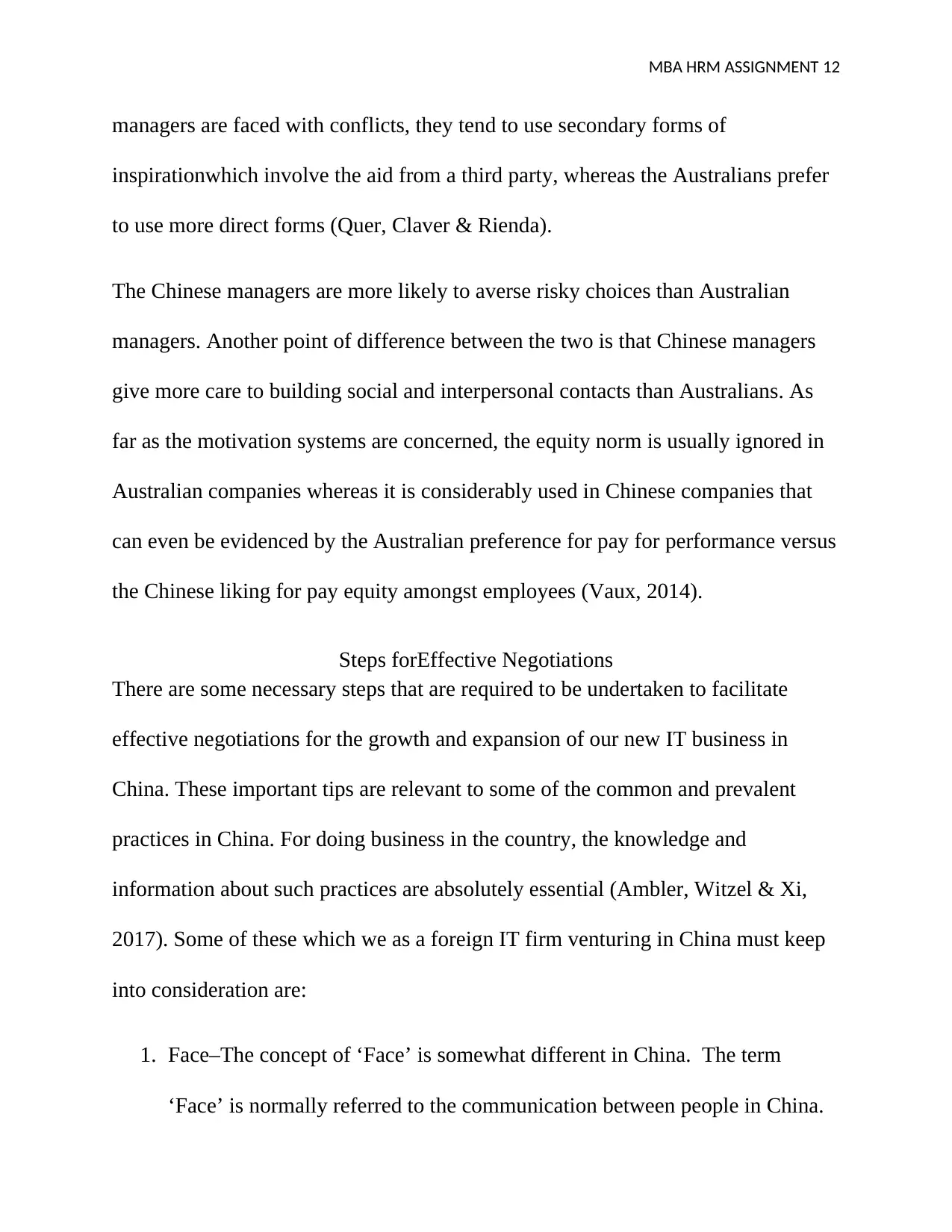
MBA HRM ASSIGNMENT 12
managers are faced with conflicts, they tend to use secondary forms of
inspirationwhich involve the aid from a third party, whereas the Australians prefer
to use more direct forms (Quer, Claver & Rienda).
The Chinese managers are more likely to averse risky choices than Australian
managers. Another point of difference between the two is that Chinese managers
give more care to building social and interpersonal contacts than Australians. As
far as the motivation systems are concerned, the equity norm is usually ignored in
Australian companies whereas it is considerably used in Chinese companies that
can even be evidenced by the Australian preference for pay for performance versus
the Chinese liking for pay equity amongst employees (Vaux, 2014).
Steps forEffective Negotiations
There are some necessary steps that are required to be undertaken to facilitate
effective negotiations for the growth and expansion of our new IT business in
China. These important tips are relevant to some of the common and prevalent
practices in China. For doing business in the country, the knowledge and
information about such practices are absolutely essential (Ambler, Witzel & Xi,
2017). Some of these which we as a foreign IT firm venturing in China must keep
into consideration are:
1. Face–The concept of ‘Face’ is somewhat different in China. The term
‘Face’ is normally referred to the communication between people in China.
managers are faced with conflicts, they tend to use secondary forms of
inspirationwhich involve the aid from a third party, whereas the Australians prefer
to use more direct forms (Quer, Claver & Rienda).
The Chinese managers are more likely to averse risky choices than Australian
managers. Another point of difference between the two is that Chinese managers
give more care to building social and interpersonal contacts than Australians. As
far as the motivation systems are concerned, the equity norm is usually ignored in
Australian companies whereas it is considerably used in Chinese companies that
can even be evidenced by the Australian preference for pay for performance versus
the Chinese liking for pay equity amongst employees (Vaux, 2014).
Steps forEffective Negotiations
There are some necessary steps that are required to be undertaken to facilitate
effective negotiations for the growth and expansion of our new IT business in
China. These important tips are relevant to some of the common and prevalent
practices in China. For doing business in the country, the knowledge and
information about such practices are absolutely essential (Ambler, Witzel & Xi,
2017). Some of these which we as a foreign IT firm venturing in China must keep
into consideration are:
1. Face–The concept of ‘Face’ is somewhat different in China. The term
‘Face’ is normally referred to the communication between people in China.
⊘ This is a preview!⊘
Do you want full access?
Subscribe today to unlock all pages.

Trusted by 1+ million students worldwide
1 out of 22
Related Documents
Your All-in-One AI-Powered Toolkit for Academic Success.
+13062052269
info@desklib.com
Available 24*7 on WhatsApp / Email
![[object Object]](/_next/static/media/star-bottom.7253800d.svg)
Unlock your academic potential
Copyright © 2020–2025 A2Z Services. All Rights Reserved. Developed and managed by ZUCOL.





